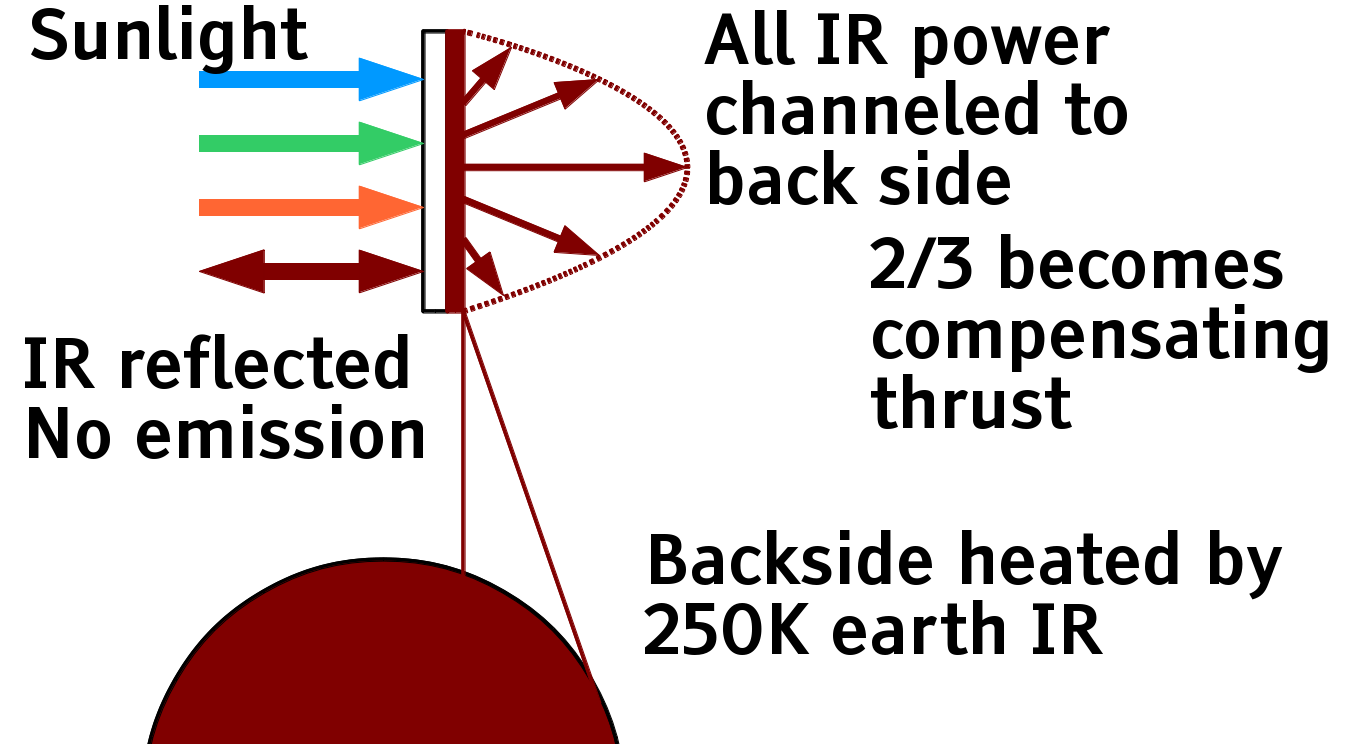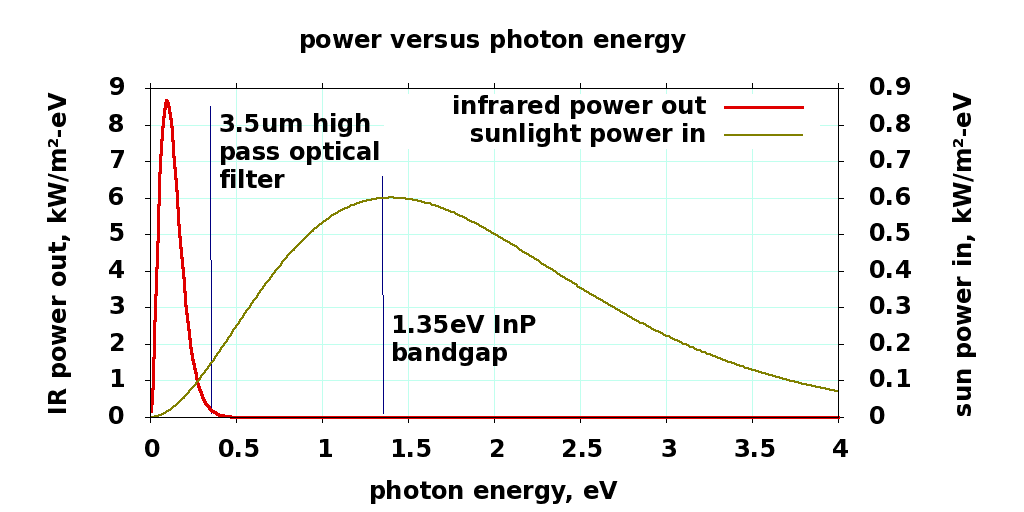Infrared Bandpass Filtered Thinsats
|
Adding an optical high-pass filter to the front (sunwards) side of a thinsat allows almost all the high energy sunlight to reach the solar cells, while pushing all the black body thermal emissions to the back side. The infrared emissions create light pressure thrust that balances 2/3 of the front side thrust, reducing orbit-distorting light sail thrust to 1/3 of the thrust caused by light absorption on the solar cells in front. |
Backside Infrared Thrust
Solid angle is the two dimensional "angular area" of something projected onto a unit sphere. The solid angle of the whole sphere is 4π steradians;, the solid angle of a half-sphere is 2π steradians;, the solid angle of a 1 degree wide band around any circumference of the sphere is 4π sin( 0.5° ) ≅ 0.1097 ster . A 1° radius circle is 9.570E-4 ster, and the visual size of the earth seen from the m288 orbit, close to 30° radius, is 2π( 1-cos(30°) ) ≅ 0.8418 ster.
Black body radiation from a flat surface is Lambertian - the intensity of the radiation per solid angle observed is constant. Perpendicular to the surface, a disk appears round with maximum solid angle. At angle \theta from perpendicular, the disk appears just as "bright" but the disk appears elliptical; just as bright per solid angle, but the solid angle size is smaller. Lambertian radiation means the intensity of the solid angle is the same, it just looks smaller so less radiation comes at you as the angle increases, dropping to zero edge-on. The radiation intensity at angle \theta is I_0 \cos( \theta ) where I_0 is a constant we shall calculate now.
For a thin band with an angle of \theta and width d\theta, the solid angle receiving the radiation is 2 \pi \sin( \theta ) d\theta and the radiation received is 2 \pi I_0 \cos( \theta ) \sin( \theta ) d\theta , or \pi I_0 \cos( 2 \theta ) d\theta . The total power P is the integral of this for \theta between 0 and \pi/2, so P = \pi I_0 or I_0 = P/\pi .
The light pressure thrust is proportional to power divided by the speed of light c . Perpendicular emissions create a perpendicular thrust, thrust at right angles to the perpendicular creates zero perpendicular thrust, and thrust at angle \theta from the perpendicular creates \cos( \theta ) times the perpendicular thrust. The perpendicular thrust from the band an angle of \theta and width d\theta is dF = ( 2 \pi I_0 / c ) \cos( \theta )^2 \sin( \theta ) d\theta = ( 2 P / c ) \cos( \theta )^2 \sin( \theta ) d\theta . Again integrating for \theta between 0 and \pi/2, the total force F = 2P/3 c , 2/3 of the light pressure thrust if the thermal radiation all came perpendicularly out the back. While it would be nice to beam ALL the thrust backwards captured by the front, summing to a total thrust of zero, that is not thermodynamically possible. Reducing the sum of frontside and backside thrust to 1/3, and reducing launch mass in proportion, is still Very Nice.
Note to perpetual motion machinists: A beam of light has a property called Etendue (ay-tahn-doo), a measure of the disorganization of the beam. Perfectly collimated light has an etendue of zero, all the rays are parallel. Disorganized light leaves a surface with rays scattering in all directions, and has higher etendue. No combination of mirrors and lenses can reduce etendue of the whole beam, the quantity always increases. Black body radiation has maximum etendue; there's no way to focus it on a spot smaller than the emitting surface. If you could, that spot could be hotter than the source, violating the second law of thermodynamics.
Front side absorption and thrust versus IR filter energy cutoff
W/m² |
|
|
1366 |
sun power |
|
1347 |
emitted power |
|
1347 |
absorbed power |
|
19.1 |
reflected power |
|
8.9 |
IR power emitted frontside |
|
1338 |
IR power emitted backside |
|
499.1 |
forward thrust power |
|
573.7 |
photovoltaic illumination |
|
|
|
|
|
|
|
120°C |
Thinsat temperature |
|
0.87 |
thrust/photovoltaic ratio |
|
3.5 μm |
filter wavelength |
|
source . . gnuplot source |
||
MoreLater: A description of the midnight flip maneuver.
Absorbing heat from the earth during the night side flip
First, let's compute the infrared we get from the 260K earth. That will be a disk with a solid angle radius \rho_E of about 30 degrees. The distance or curvature of the disk does not matter, only the solid angle does. The amount of heat deposited on the Lambertian surface of the thinsat is a function of angle, the cross product of two vectors. One unit vector \vec P is perpendicular to the surface of the thinsat, the other unit vector \vec E is pependicular to the center of the disk.
The disk can be projected onto a unit sphere, and decomposed into rings with angular radius \phi and width d\phi , then further decomposed into pixel elements at angle \theta and width d\theta , an element with vector \vec \alpha( \theta, \phi ) . That vector can be decomposed into \vec \alpha( \theta, \phi )\parallel , a vector parallel to \vec D , and \vec \alpha( \theta, \phi )_\perp , perpendicular to \vec D . | \vec \alpha( \theta, \phi )_\parallel | = \cos( phi ) and | \vec \alpha( \theta, \phi )_\perp | = \sin( \phi ) If we sum the vectors \vec \alpha( \theta, \phi ) and \vec \alpha( (\theta + \pi), \phi ) , then the sin() perpendicular elements cancel, and so | \vec \alpha( \theta, \phi ) + \vec \alpha( (\theta + \pi), \phi ) | = 2 \cos(\phi) . The same is true for all pairs of elements around the circle, so the effective solid angle of the ring (radius 2 \pi \sin( \phi ) ) is 2 \pi \sin( \phi ) \cos( \phi ) d\phi = \pi \sin( 2 \phi ) d\phi .
We can easily integrate all those rings in the disk into a solid angle vector { \pi \over 2 } ( 1 - \cos( 2 \rho ) ) in direction of \vec D . The amount of heat radiation reaching the thinsat is proportional to { \pi \over 2 } ( 1 - \cos( 2 \rho ) ) ( \vec P \bullet \vec D ) . If the angle between \vec P and \vec D is e , then \vec P \bullet \vec D = \cos( e )
We know that if the thermally one-sided thinsat was pointed into a half-sphere, \rho = \pi / 2 and \vec P = \vec D , then the temperature of the thinsat equals the temperature of the half-sphere, T_s = T_h . The heat radiation would be proportional to \pi { T_h }^4 . If instead we are looking at the \rho_e radius earth ( temperature T_e ), at an angle of e from thinsat perpendicular, the amount of heat will be proportional to 0.5 ( 1 - \cos( 2 \rho_E ) ) \cos( e ) \approx 0.25 \cos( e ) and the temperature will be the 4th root of that quantity squared times 260K.
At the equinoxes, the eclipse time is 1/6 of the 240 minute sidereal orbit, 40 minutes. At the start of eclipse, the thinsat points at the terminator, 30° away from the center or the earth, e = 60°, the heat is 1/8th of the full surround case, and the temperature drops towards 0.595 times 260K, or 155K. At the middle of the eclipse 20 minutes later, the backside points directly at the center of the earth, e = 0° and the temperature increases towards 184K. Over the next 20 minutes, the temperature drops back down towards 155K. The rate at which it changes will depend on the small heat storage in the aluminum substrate; not very much for a thinsat!
An IRfiltered thinsat which doesn't turn will capture only the slight amount of heat energy from the earth with wavelengths shorter than 3.5μm wavelength, then radiate it out the backside into 2.7K space. Depending on the sharpness of the filter, the thinsat might drop below 20K. Subjecting the thinsat to that kind of thermal shock for a few percent extra power is not worth it.
Version 4 thinsats with twice the radiator surface would drop temperature by another 16%, to 130K and 155K respectively with the backside flip. A version 4 thinsat in max power mode will range from 149K to 155K.


